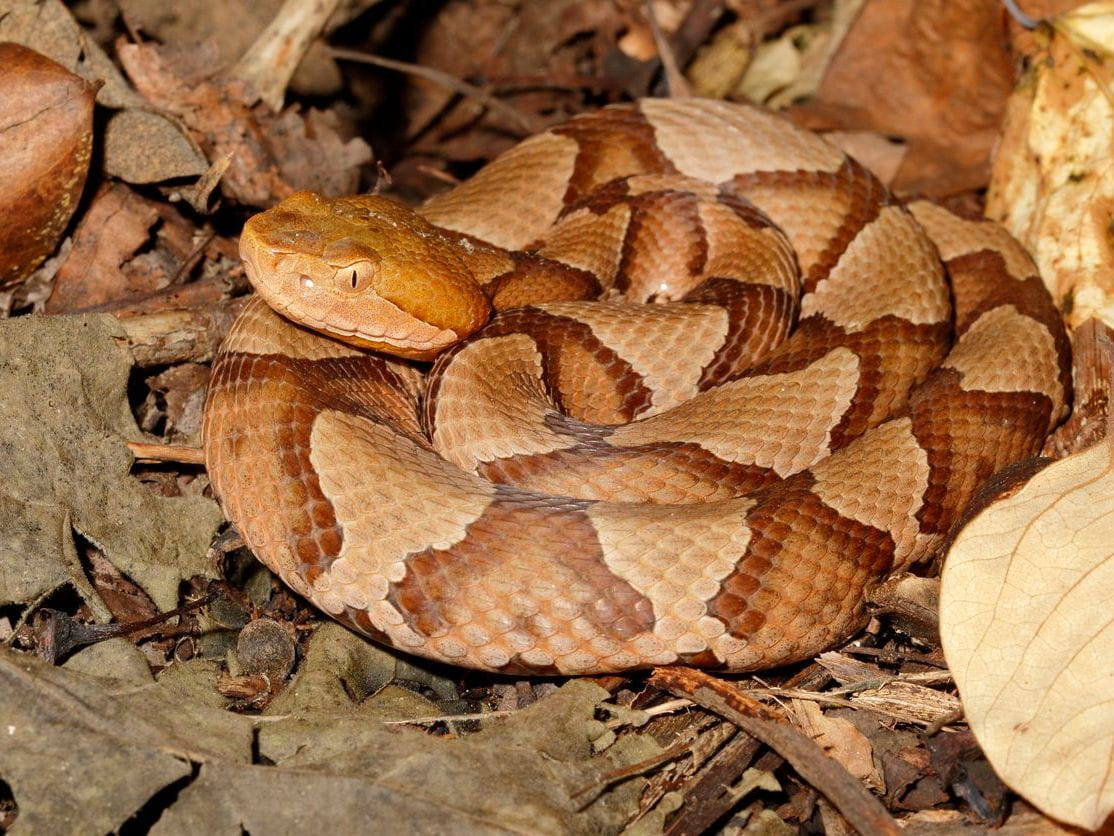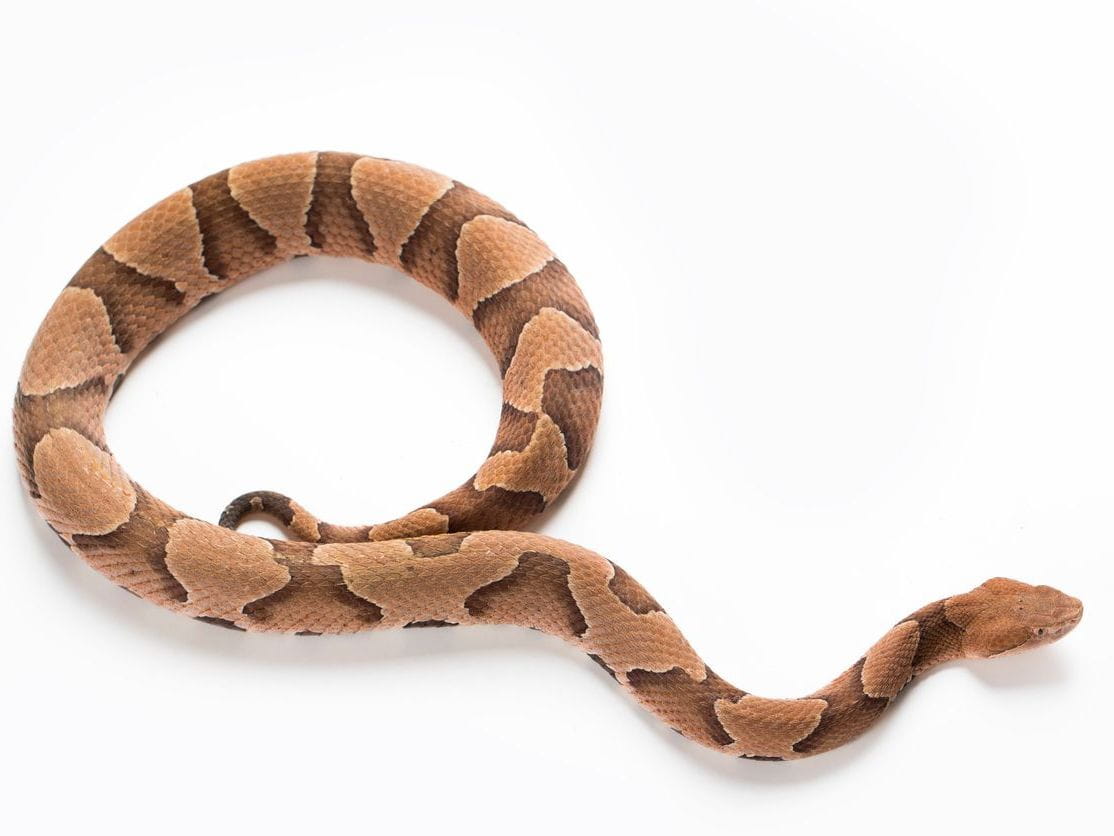Are Copperhead Snakes Venomous?

The Bottom Line
Copperheads are venomous snakes. Their bites can cause local pain, swelling, redness, bruising, and blistering, as well as systemic symptoms like low blood pressure and bleeding. In some cases, no symptoms are present. Serious effects are rare. If a bite occurs, stay calm, immobilize the bite area, and seek help from experts.

Where do copperhead snakes live, and what do they look like?
Copperheads are found in the eastern and central US. They live in mountains, forests, rock piles, and woodpiles, as well as under bushes and in suburban housing areas. Copperheads usually have a brownish, copper-colored body with darker hourglass-shaped crossbands. They have triangular heads with 2 heat-sensing pits, 2 fangs, and eyes with elliptical pupils. The underside of the tail has a single row of scales. An adult copperhead is usually 2–3 feet long, while baby copperheads are 7–9 inches long. Baby copperheads also have hourglass-shaped bands, but their base color can be tan or gray rather than coppery.How to identify a copperhead snake.
Copperheads can be identified by their size, coppery color, hourglass-shaped bands, and triangular-shaped heads. Avoid any snake with these features, since it is unsafe to get close enough to check for the facial pits and eye shape. In the US, any snake with slit-like pupils should be considered poisonous, but not all poisonous snakes have slit-like pupils.What do you do if you see a copperhead snake?
If you see a copperhead, leave it alone. If it is on your property, call Animal Control to remove it.How do you keep copperhead snakes away?
To decrease the likelihood of copperheads on your property, remove leaves, rocks, trash, and other debris, as well as tall vegetation, from around your home. Be especially careful from April to September, when copperheads are most active and bites are more likely to occur.Are copperhead snakes venomous?
Yes, copperhead snakes are venomous. They are in the Crotalinae subfamily of snakes, which includes other venomous snakes such as rattlesnakes and cottonmouths.What are the symptoms of a copperhead snakebite?
Symptoms of a copperhead snakebite include pain, progressive swelling, skin redness, bruising, and blood blisters. Some people experience nausea, vomiting, weakness, low blood pressure, and bleeding. There might be no symptoms of a copperhead bite, since 20–25% of bites are “dry bites.” That means the snake did not inject any venom. Another 15% of copperhead bites are trivial bites, meaning symptoms are minor. There will usually be two puncture marks following a copperhead snakebite, although sometimes only one. Symptoms evolve over 8–12 hours. Serious systemic effects are rare.What should I do if I’ve been bitten by a copperhead snake?
Stay calm, limit activity, and try to keep warm. Remove constricting items, such as jewelry or tight clothing. Immobilize the bite area below the heart. Mark the edge of the swelling with a pen. Go to the nearest hospital. Do not apply a tourniquet (constricting band), pack the wound in ice, cut and suck the wound, or use electric shock therapy. Once you are at a hospital and have significant local symptoms from the bite, you might be treated with an antivenin, which helps counteract the snake venom.
If you are bitten by any snake, seek help from experts by calling 1-800-222-1222. Poison Control’s expert guidance is always free, confidential, and available 24 hours a day.
Wendy Klein-Schwartz, Pharm.D., MPH
Clinical Toxicologist
Poison Control Media Information
Did you find this page helpful? If so, we need your support. Poison Control is in constant competition with misinformation online. Links to www.poison.org or our webPOISONCONTROL triage tool from other websites and blogs help internet searchers quickly find accurate information and Poison Control’s contact information in an emergency. If you use the content from this page, please provide attribution via a link back to this page, www.poison.org, or https://triage.webpoisoncontrol.org/#!/exclusions. By doing so, you could save a life. Thank you!
Poisoned?
Call 1-800-222-1222 or
Prevention Tips
- Stay well away from all snakes in the wild.
- Look carefully before reaching into vegetation.
- Be careful when stepping over logs or rocks or in leaves or other debris.
- Wear heavy boots when hiking.
- If you see a snake, leave it alone.
- Do not try to catch or kill a snake.
This Really Happened
A 32-year-old woman was weeding her vegetable garden. She was reaching into an area dense with weeds when she felt a stinging pain in her thumb. She looked down and saw a copper-colored snake slithering away. Her thumb showed two puncture marks. The pain worsened, and her thumb started to swell. She called Poison Control and was told to go to the emergency room at the nearest hospital. Her husband drove her to the hospital, which was only 10 minutes from their home. She developed bruising and was experiencing significant pain. The swelling continued to progress above her wrist, so she was treated with antivenin. The antivenin stopped the progression of the swelling. When she left the hospital the next day, she still had some swelling and pain, although it was less severe. She was told that it could take a couple of weeks to fully recover.For More Information
Soloway RAG. What to do for a snakebite. Poison.org. Accessed May 17, 2024.
References
Roth B, Sharma K, Onisko N, Chen T. Prospective evaluation of pain, swelling, and disability from copperhead envenomaton. Clin Toxicol (Phila). 2016;54(3):271-276.
Ruha AM, Kleinschmidt KC, Greene S, Spyres MB, Brent J, Wax P, Padilla-Jones A, Campleman S; ToxIC Snakebite Study Group. The epidemiology, clinical course, and management of snakebites in the North American Snakebite Registry. J Med Toxicol. 2017;13(4):3090320.
Thorson A, Lavonas EJ, Rouse AM, Kerns WP. Copperhead envenomations in the Carolinas. J Toxicol Clin Toxicol. 2003;41(1):29-35.
Warpinski GP, Ruha AM. North American envenomation syndromes. Emerg Med Clin North Am. 2022;40(2):313-326.
Poisoned?
Call 1-800-222-1222 or
Prevention Tips
- Stay well away from all snakes in the wild.
- Look carefully before reaching into vegetation.
- Be careful when stepping over logs or rocks or in leaves or other debris.
- Wear heavy boots when hiking.
- If you see a snake, leave it alone.
- Do not try to catch or kill a snake.
